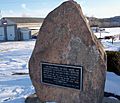Battle of Salineville facts for kids
Quick facts for kids Battle of Salineville |
|||||||
|---|---|---|---|---|---|---|---|
| Part of American Civil War | |||||||
|
|||||||
| Belligerents | |||||||
| Commanders and leaders | |||||||
| James M. Shackelford | John Hunt Morgan |
||||||
| Units involved | |||||||
| Mixed elements of West Virginia, Kentucky, Illinois, Tennessee, Michigan and Ohio cavalry, artillery and mounted infantry | Unknown | ||||||
| Strength | |||||||
| 2,600 | 800 | ||||||
| Casualties and losses | |||||||
| None | 364 | ||||||
The Battle of Salineville happened on July 26, 1863. It was fought near Salineville, Ohio, during the American Civil War. This battle was part of a big event called Morgan's Raid. It was the farthest north that an official group of Confederate soldiers ever fought. The Union army won this battle. This victory broke up John Hunt Morgan's remaining Confederate cavalry (soldiers on horseback). It also led to his capture later that same day.
Contents
What Led to the Battle of Salineville?
In June 1863, Confederate General John Hunt Morgan started a raid. He left his camp in Tennessee with 2,460 soldiers. His goal was to make the Union army in Ohio look away from other Southern forces.
Morgan Crosses the Ohio River
On July 8, 1863, Morgan crossed the Ohio River at Brandenburg, Kentucky. He entered Indiana, even though his orders said to stay in Kentucky. After winning a battle at Corydon, Morgan moved east into Ohio. Union troops, led by General James M. Shackelford, chased him.
Escape Attempts and Union Pursuit
On July 19, Morgan tried to cross the Ohio River back into West Virginia. This happened at Buffington Island, near Pomeroy, Ohio. Some of his men did make it across the river and back to the South. But Union forces captured about 800 to 1,200 of Morgan's soldiers. About 300 men, led by Colonel Adam "Stovepipe" Johnson, managed to cross the river farther upstream.
General Morgan and his remaining 400 men were cut off from the river. They could not cross back. When another try to cross the river failed, he headed north. He hoped to find another spot to cross the Ohio River and return South. His path took him through many scared towns. These included Moorefield, Harrisville, and Richmond. Morgan's horses were tired, and his men were exhausted. Union soldiers kept chasing him, blocking his way to the river.
The Battle and Morgan's Capture
Union General Shackelford kept chasing Morgan. He led a mixed group of soldiers. These included cavalry, artillery (big guns), and mounted infantry (soldiers who ride horses but fight on foot). These troops came from many states, like Illinois, Kentucky, West Virginia, and Ohio. The Steubenville Militia also joined the chase.
Morgan's Forces Trapped
Morgan's tired men were alone and constantly chased. They were going deeper into enemy land. Finally, Union forces surrounded Morgan on July 26, 1863. This happened at Salineville, near Lisbon, Ohio. Morgan's men were greatly outnumbered. He tried to fight his way out from about 3,000 Union soldiers.
The Fight and Surrender
Morgan lost 364 men in a short fight. This included 23 dead, several wounded, and almost 300 captured. The battle lasted less than two hours. Amazingly, General Morgan and a few of his men first managed to get away. But at 2:00 p.m., they gave up. They surrendered to Union Major George W. Rue of the 9th Kentucky Cavalry. This happened near West Point, Ohio. This spot is about 8 miles northeast of Salineville. Today, a historical marker shows where Morgan surrendered.
Major Rue later said that Morgan first tried to surrender to one of his own prisoners. This prisoner was an Ohio Militia captain named Burbridge. This captain then supposedly let Morgan and his officers go free. This would have allowed them to return home. But Major Rue ignored that "surrender." He made Morgan formally surrender to the Union forces. Union troops took Morgan to Columbus, Ohio. He and many of his officers were put in the Ohio Penitentiary (prison). Many of his captured soldiers went to other prisoner of war camps in the North.
The Surrender Inquiry
In July and August 1863, Ohio Governor David Tod looked into Morgan's surrender. Governor Tod found out that Captain Burbridge was actually James Burbick. He was a regular citizen from New Lisbon, Ohio. He had never been an officer in the Ohio Militia. So, Governor Tod decided that Burbick had no power over Morgan. This meant Morgan's surrender to the Union forces was official.
Farthest North Dispute
The Battle of Salineville was the farthest north an official Confederate army group fought. However, another Confederate action, the St. Albans Raid, happened even farther north. On October 19, 1864, 21 Confederates came from Canada. They raided St. Albans, Vermont. But these raiders were not an official part of the Confederate army. Historians link the St. Albans raid to the Confederate Secret Service. General Morgan's surrender spot at West Point is still seen as the northernmost point reached by an officially organized Confederate group during the Civil War.
Images for kids



